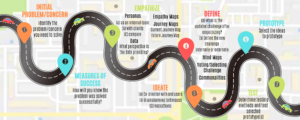Prototyping is the fourth step in the design thinking process. It occurs after the ideation phase, where you have pared down your ideas to the best of the best. At the prototyping phase, you are ready to design an early version of the solution. This phase is one of the best ways to reveal how your users think and feel about a product or solution and can help you resolve any uncertainties around the idea you have selected. Creating multiple prototypes takes the risk out of innovation by allowing you to fail quickly – and keeps you from spending time and money on an idea that may not actually work in practice.
How does prototyping support the design process? It helps you see your solution differently. It takes your idea from being an abstract concept to the real world to see how it may behave differently. The prototyping phase is important for learning more about how users will act with your end solution. We recommend working with users whenever possible to co-create multiple prototypes. You will want to record, observe, and/or measure user performance with each prototype you put in front of users.
Using the top ideas you selected from the ideate phase, start to build inexpensive, tangible prototypes. You may use both low-fidelity prototypes and high-fidelity prototypes. Low-fidelity prototypes work out the primary or core elements of what the solution needs to do or visualize what it could be. The materials used are not what the end product will be made of but are quick and inexpensive, and accessible ways to prototype. High-fidelity prototypes will be closer to the actual end product and allow for more compelling and rigorous user testing so you can be more confident in how your users will respond to the solution. However, they take much longer to create, and it can be challenging to make changes once finished.

There are different prototyping methods, such as storyboarding, wire-frame prototypes, paper prototypes, and more. You can even use Lego to build low-fidelity prototypes! Whichever method you use should be relevant to the product/solution you are designing for, whether it is a physical product, a website, digital service, etc. Of course, you should test whether your prototype really solves your users’ problems as planned. It should also address ease of use and functionality. The important part is to remember your challenge statement from the define phase, start building and don’t take too much time.
It’s important to note that your first round of prototyping may not always lead you to your end solution. You may go through a few rounds of prototypes, or you may find that you will discover something new about the problem, which will lead you back to the Define, Ideate, or even Empathize Phases. Prototyping can save organizations time and money in the long run because it allows you to gain valuable insights about the problem you are trying to solve that can only be discovered using tangible versions of the solution.
For more information on prototyping, check out Spring2 Innovation’s YouTube channel:
As part of Spring2 Innovation’s Design Thinking Certification, we teach you and your team how to master all five phases of the Design Thinking methodology. Participants learn how to apply design thinking tools and methodologies from a solution-based lens with the end-user in mind.
Master all five phases of Design Thinking:
Click here for more information about our Design Thinking Certification program
